Cytoplasm-Definition, Structure, Functions, and Importance
What is Cytoplasm?
Cytoplasm is the gel-like material that fills a cell and surrounds the organelles. It provides the supporting framework and optimum internal environment for organelles.
In biology, the cytoplasm is a rich, semi-solid material present in the cells of organisms.
The cytoplasm is enclosed by the plasma membrane. It contains various components, such as the cytosol and different organelles. Some scientists consider the nucleus a part of the cytoplasm.
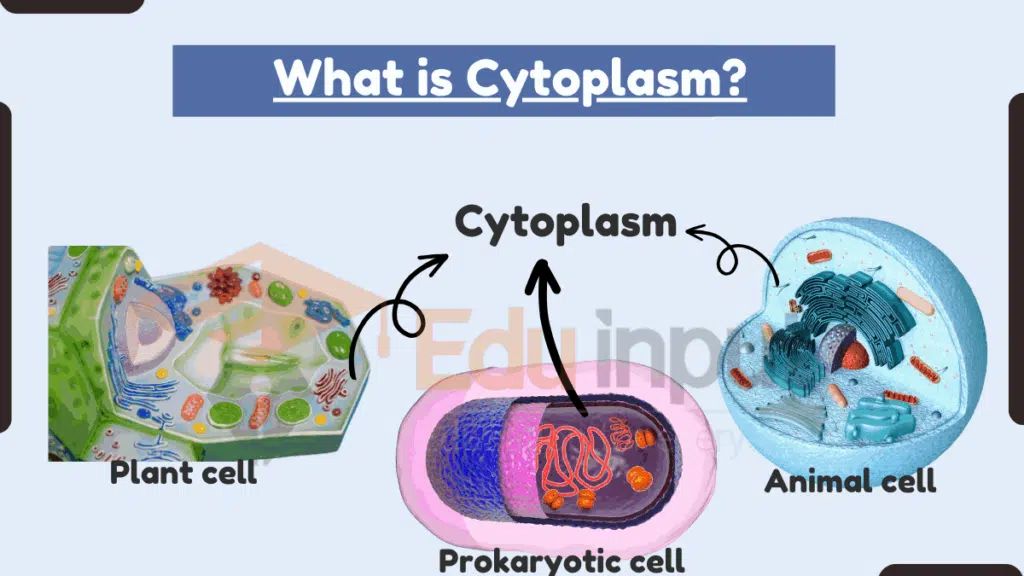
Cytoplasm Diagram
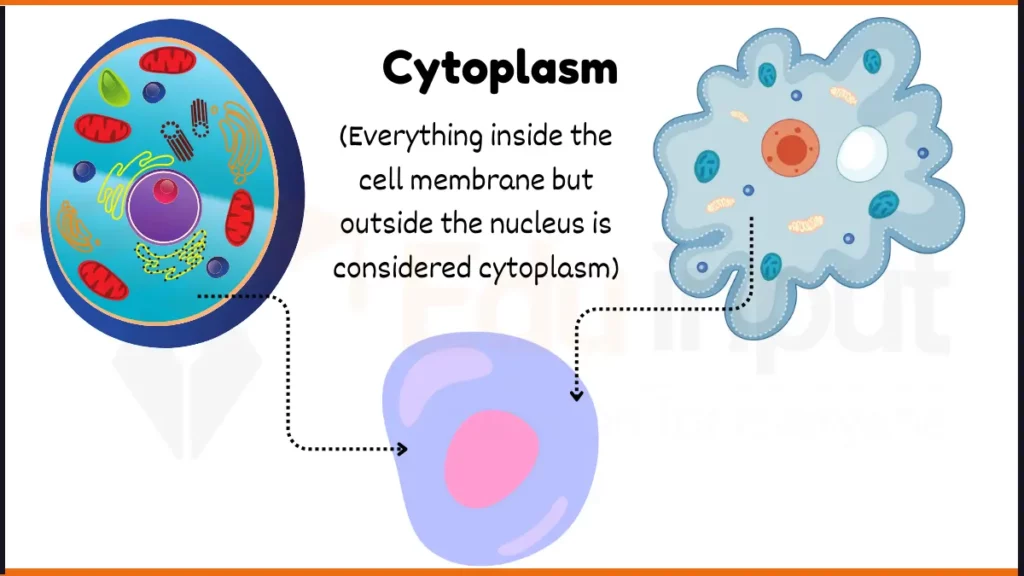
Analogy for Cytoplasm
Here are a few analogies to understand cytoplasm in better way:
1. Analogy of cytoplasm in a school
The cytoplasm is like the hallways of a school. It is a jelly-like substance that contains all of the organelles, which are like the different classrooms and offices in the school. The cytoplasm allows the organelles to move around and interact with each other, just like the hallways allow students and teachers to move around and interact with each other.
2. Analogy of cytoplasm in a house
The cytoplasm is like the air in a house. It is everywhere and it surrounds all of the furniture and appliances, which are like the organelles in the cell. The cytoplasm allows the organelles to communicate with each other and to transport materials, just like the air allows people to communicate with each other and to move around the house.
3. Analogy of cytoplasm in comparison to a person
The cytoplasm is like the blood and lymph in a person’s body. It is a fluid that transports nutrients and oxygen to all of the cells in the body, and it removes waste products from the cells. The cytoplasm also helps to regulate the body’s temperature and to protect the cells from infection.
4. Analogy of cytoplasm in a city
The cytoplasm is like the streets and sidewalks in a city. It allows people and goods to move around from one place to another. The cytoplasm also contains all of the infrastructure, such as the power grid and the water system that supports the city.
Structure of Cytoplasm
The cytoplasm is composed of a gel-like cytosol containing dissolved molecules and suspended organelles that carry out specialized functions within the cell.
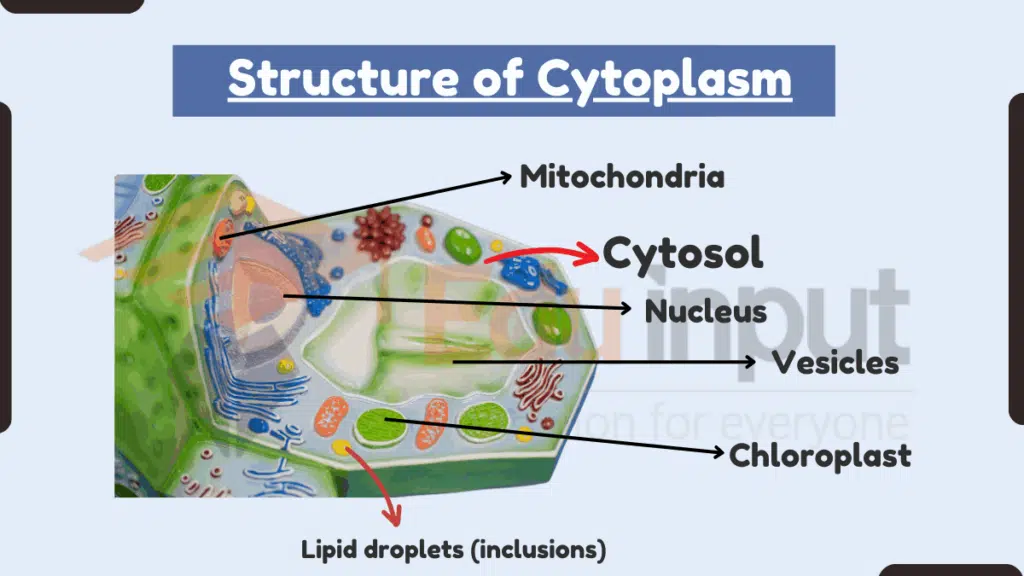
Here are the main components of cytoplasm:
1. Cytosol
Cytosol is the liquid part of cytoplasm. Components of cytosol are water, ions, carbohydrates, lipids, proteins, and nucleotides.
Water makes up majority of cytosol and creates aqueous environment for biochemical reactions.
Ions like sodium, potassium, calcium, magnesium, chloride, phosphate, and sulfate are also present in cytosol.
Structural, enzymatic, signaling, transport proteins are dissolved in cytosol.
Carbohydrates, and lipids like Phospholipids, and triglycerides are present in small amounts.
2. Organelles
The major organelles suspended in the cytosol are:
- Nucleus – Has nuclear envelope and contains chromatin with DNA and the nucleolus.
- Endoplasmic Reticulum – Network of membranous tubules and sacs involved in lipid synthesis and protein modification.
- Golgi apparatus – Flattened stacked sacs that sort, package, and modify proteins.
- Mitochondria– Double-membraned powerhouses that produce ATP via cellular respiration. Have inner folded cristae.
- Lysosomes – Spherical vesicles containing digestive enzymes to break down waste.
- Peroxisomes – Small vesicles housing enzymes for lipid metabolism.
- Vacuoles – Fluid-filled sacs that store metabolites, waste, water, or food.
- Cytoskeleton – Protein filaments including microfilaments, microtubules, and intermediate filaments. Provide cell shape and structure.
3. Inclusions
The cytoplasm also contains inclusions like:
- Glycogen granules – Storage form of glucose
- Lipid droplets – Storage form of lipids
Do all cells have cytoplasm?
All cells (e.g animal, plant, algae, fungi) have cytoplasm. However, the size of the cytoplasm varies from cell to cell. For example, sperm cells in humans lose much of their organelles to achieve a complex nucleus for a more streamlined structure for its motility at maturity.
Thus it possesses small-sized cytoplasm. While the ovum is the largest cell of the human body as it possesses a larger-sized cytoplasm.
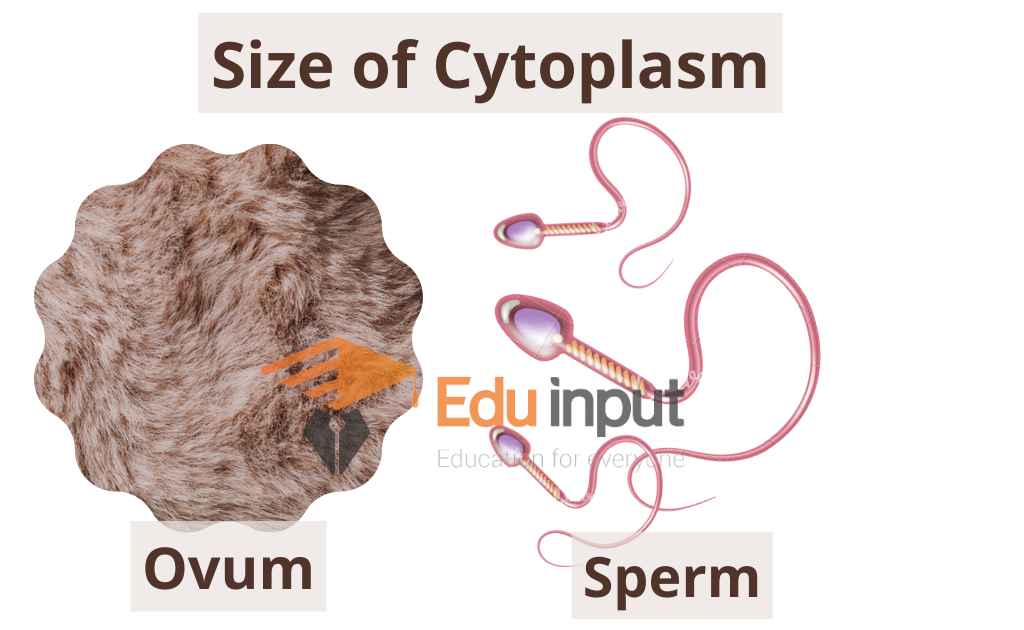
Physical Nature of Cytoplasm
The cytoplasm serves both the purpose of mobility of the cell and structure maintenance for the cell. It allows organelles to move throughout the cell while ensuring that the cell itself has a solid structure.
Cytoplasmic Streaming
Cytoplasmic streaming is also called protoplasmic streaming and cyclosis. It is the circular motion of cytosol and organelles around the interior of a cell. Cytoskeleton, including actin filaments and microtubules, and motor proteins support the movement of cytosol.
This streaming helps to distribute nutrients, proteins, and organelles throughout the cell. There are different types of cytoplasmic streaming, such as rotational streaming and shuttle streaming.
Streaming allows efficient transport and mixing within large stationary plants and algal cells. Disruption of cytoplasmic streaming can impair circulation and lead to defects.
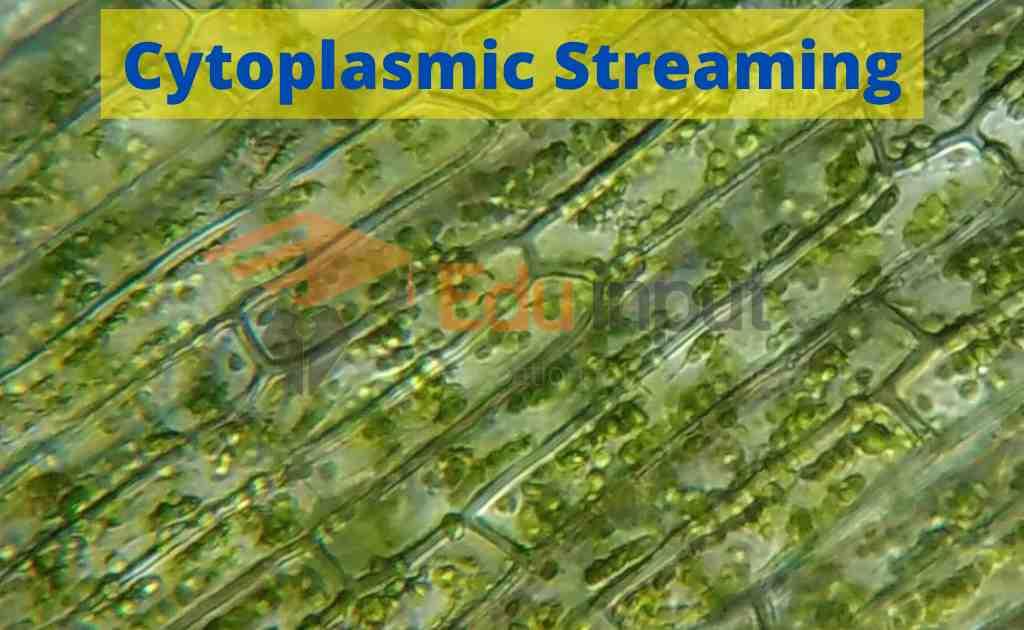
Role of Cytoplasm in Cytokinesis
When cell division occurs during the cell cycle, the cytoplasm divides as well to become part of the new cells. This division of the cytoplasm is called cytokinesis. Cytokinesis occurs during meiosis or mitosis of the cell.
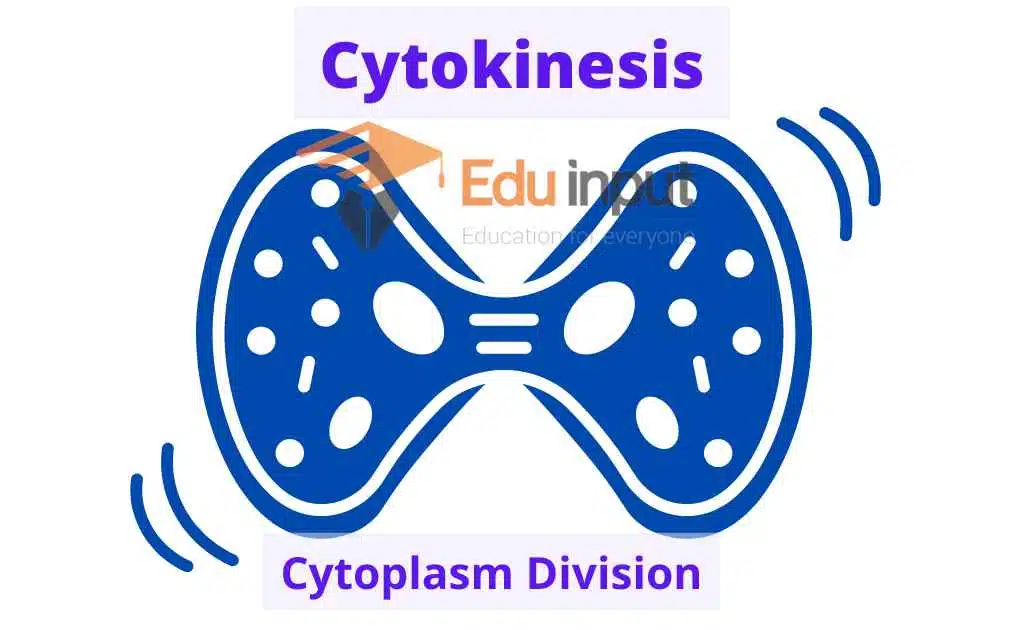
Functions of Cytoplasm
The cytoplasm is the site of cellular metabolism, molecular transport, structural support, storage, waste disposal, cell signaling, cell growth, and division.
Here are the main functions of cytoplasm in animal and plant cell:
1. Cellular metabolism
Many metabolic pathways, including glycolysis, protein synthesis, and lipid metabolism, occur in the cytoplasm. Enzymes located in the cytoplasm catalyze these reactions.
2. Molecular transport
The cytoplasm allows the movement of molecules such as proteins and RNAs between different compartments. For example, proteins synthesized by ribosomes in the cytoplasm need to be transported to various organelles.
3. Structural support
The gel-like cytosol provides shape and support to the cell, while the cytoskeleton maintains the cell’s integrity.
4. Storage
Metabolites such as glycogen and lipids can be stored in the cytoplasm for later use as an energy source.
5. Waste disposal
Cellular waste products are broken down in the cytoplasm by lysosomes before being removed from the cell.
6. Cell signaling
Receptor proteins on the cell surface relay signals to effector proteins inside the cytoplasm, enabling cell response to external stimuli.
7. Cell growth and division
The cytoplasm increases in volume as the cell grows before dividing. The cytoplasm partitions between daughter cells during division.
8. Site of translation
Messenger RNAs are translated into proteins by ribosomes present in the cytoplasm.
Why is cytoplasm important?
The cytoplasm is crucial for cell survival and function. This gel-like material that fills the cell provides the space, molecules, and proteins needed for essential metabolic reactions, transport, signaling, waste removal, and growth.
Enzymes suspended in the aqueous cytosol catalyze reactions like protein synthesis and cell respiration that the cell depends on.
Cytoskeletal elements give structural support and enable transport of substances from one area to another. The cytoplasm harbors the organelles and inclusions necessary for cell function while also storing metabolites for energy.
Communication between the exterior and interior of the cell relies on receptor proteins embedded in the cytoplasmic membrane that activate intracellular signaling cascades.
Without the cytoplasm and its components, the organelles would not have an optimal internal environment to carry out their jobs, and the cell could not conduct basic functions needed for maintaining life.
Frequently Asked Question-FAQs
Do plant cells have cytoplasm
Yes, plant cells have cytoplasm. Plant cells have a slightly different composition of cytoplasm than animal cells. For example, plant cells have a large central vacuole, which is a fluid-filled sac that helps to maintain the cell’s turgor pressure.
During what process are the contents of both the nucleus and the cytoplasm divided?
Mitosis is the process by which a cell divides into two identical daughter cells. It involves the division of both the nucleus and the cytoplasm.
Do prokaryotic cells have cytoplasm
NO, prokaryotes do not have any nucleus.
Is cytoplasm living or non-living?
Cytoplasm is the living part of the cell, where most of the biological processes occur.
What is the pH of cytoplasm?
Cell performs efficiently in the pH range of 6.5-8.0. A little change in pH can affect the survival of the cell. Thus pH inside the cell is close to 8.0.
What is the difference between the cytoplasm in prokaryotic and eukaryotic cells?
In prokaryotic cells, the cytoplasm fills the whole space bounded by the cell membrane.
In eukaryotic cells, the cytoplasm is located between the cell membrane and nuclear membrane.
What does cytoplasm look like?
Cytoplasm is the jelly-like substance that fills the cell between the nucleus and the cell membrane. It contains all of the organelles of the cell, including the mitochondria, ribosomes, Golgi apparatus, and endoplasmic reticulum.
Which biological process takes place in the cytoplasm of a cell?
Glycolysis takes place in the cytoplasm of a cell.
What is the division of the cytoplasm called?
Division of cytoplasm is called cytokinesis.



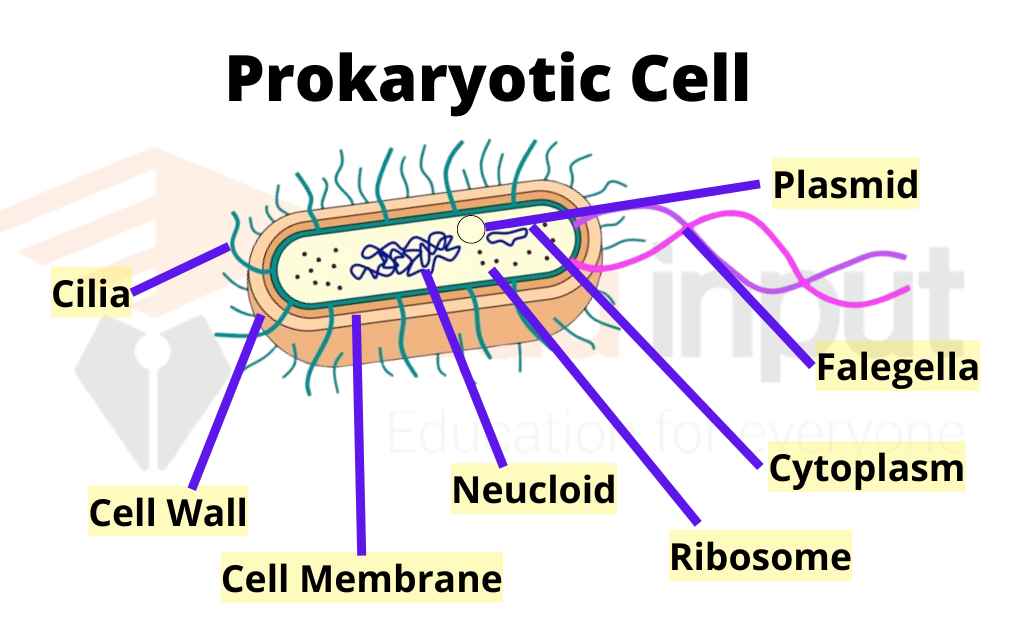


Leave a Reply